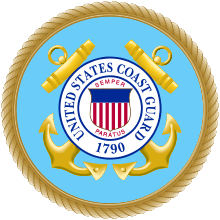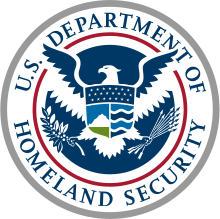United States Coast Guard
The United States Coast Guard (USCG) is the coastal defense, search and rescue, and maritime law enforcement branch of the United States Armed Forces[6] and one of the country's eight uniformed services. The Coast Guard is a maritime, military, multi-mission service unique among the U.S. military branches for having a maritime law enforcement mission with jurisdiction in both domestic and international waters and a federal regulatory agency mission as part of its duties. It operates under the U.S. Department of Homeland Security during peacetime, and can be transferred to the U.S. Department of the Navy by the U.S. President at any time, or by the U.S. Congress during times of war. Congressional authority transfers happened twice: in 1917, during World War I, and in 1941, during World War II.
Created by the U.S. Congress on 4 August 1790 at the request of Alexander Hamilton as the Revenue-Marine, it is the oldest continuous seagoing service of the United States.[Note 1] As Secretary of the Treasury, Hamilton headed the Revenue-Marine, whose original purpose was collecting customs duties at U.S. seaports. By the 1860s, the service was known as the U.S. Revenue Cutter Service and the term Revenue-Marine gradually fell into disuse.[9]
The modern Coast Guard was formed by a merger of the U.S. Revenue Cutter Service and the U.S. Life-Saving Service on 28 January 1915, under the U.S. Department of the Treasury. In 1939, the U.S. Lighthouse Service was also merged into the Coast Guard. As one of the country's six armed services, the Coast Guard has been involved in every major U.S. war since 1790, from the Quasi-War with France to the Global War on Terrorism.[10][11]
As of 2018, the Coast Guard had 40,992 active duty personnel, 7,000 reservists, and 8,577 full-time civilian employees, and 31,000 auxiliary members for a total workforce of 87,569.[2] The Coast Guard maintains an extensive fleet of 243 coastal and ocean-going patrol ships, tenders, tugs, icebreakers, and 1,650 smaller boats, as well as an aviation division consisting of 201 helicopters and fixed-wing aircraft.[12] While the U.S. Coast Guard is the second smallest of the U.S. military service branches in terms of membership, the U.S. Coast Guard by itself was the world's 12th largest naval force in 2018.[13][14]
Mission
Role

The Coast Guard carries out three basic roles, which are further subdivided into eleven statutory missions. The three roles are:
With a decentralized organization and much responsibility placed on even the most junior personnel, the Coast Guard is frequently lauded for its quick responsiveness and adaptability in a broad range of emergencies. In a 2005 article in Time magazine following Hurricane Katrina, the author wrote, "the Coast Guard's most valuable contribution to [a military effort when catastrophe hits] may be as a model of flexibility, and most of all, spirit." Wil Milam, a rescue swimmer from Alaska told the magazine, "In the Navy, it was all about the mission. Practicing for war, training for war. In the Coast Guard, it was, take care of our people and the mission will take care of itself."[15]
Missions

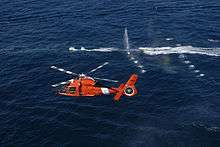
The eleven statutory missions as defined by law are divided into homeland security missions and non-homeland security missions:[16]
Non-homeland security missions
- Ice operations, including the International Ice Patrol
- Living marine resources (fisheries law enforcement)
- Marine environmental protection
- Marine safety
- Aids to navigation
- Search and rescue
Homeland security missions
- Defense readiness
- Maritime law enforcement
- Migrant interdiction
- Ports, waterways and coastal security (PWCS)
- Drug interdiction
Search and rescue

- See National Search and Rescue Committee[17]
- See Joint Rescue Coordination Centers
While the U.S. Coast Guard Search and Rescue (CG-SAR) is not the oldest search and rescue organization in the world, it is one of the Coast Guard's best-known operations.[18] The National Search and Rescue Plan designates the Coast Guard as the federal agency responsible for maritime SAR operations, and the United States Air Force as the federal agency responsible for inland SAR.[19] Both agencies maintain rescue coordination centers to coordinate this effort, and have responsibility for both military and civilian search and rescue.[20] The two services jointly provide instructor staff for the National Search and Rescue School that trains SAR mission planners and coordinators. Previously located on Governors Island, New York, the school is now located at Coast Guard Training Center Yorktown at Yorktown, Virginia.
National Response Center

Operated by the Coast Guard, the National Response Center (NRC) is the sole U.S. Government point of contact for reporting all oil, chemical, radiological, biological, and etiological spills and discharges into the environment, anywhere in the United States and its territories.[21] In addition to gathering and distributing spill/incident information for Federal On Scene Coordinators and serving as the communications and operations center for the National Response Team, the NRC maintains agreements with a variety of federal entities to make additional notifications regarding incidents meeting established trigger criteria. The NRC also takes Maritime Suspicious Activity and Security Breach Reports. Details on the NRC organization and specific responsibilities can be found in the National Oil and Hazardous Substances Pollution Contingency Plan.[22] The Marine Information for Safety and Law Enforcement (MISLE) database system is managed and used by the Coast Guard for tracking pollution and safety incidents in the nation's ports.
National Maritime Center
The National Maritime Center (NMC) is the merchant mariner credentialing authority for the USCG under the auspices of the Department of Homeland Security. To ensure a safe, secure, and environmentally sound marine transportation system, the mission of the NMC is to issue credentials to fully qualified mariners in the United States maritime jurisdiction.[23]
Authority as an armed service
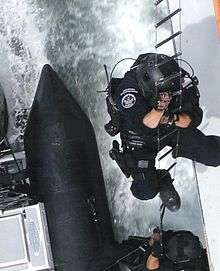
The six uniformed services that make up the U.S. Armed Forces are defined in Title 10 of the U.S. Code:
The term "armed forces" means the Army, Marine Corps, Navy, Air Force, Space Force, and Coast Guard.[24][25]
The Coast Guard is further defined by Title 14 of the United States Code:
The Coast Guard as established January 28, 1915, shall be a military service and a branch of the armed forces of the United States at all times. The Coast Guard shall be a service in the Department of Homeland Security, except when operating as a service in the Navy.[26]
Coast Guard organization and operation is as set forth in Title 33 of the Code of Federal Regulations.
On 25 November 2002, the Homeland Security Act was signed into law by U.S. President George W. Bush, designating the Coast Guard to be placed under the U.S. Department of Homeland Security. The transfer of administrative control from the U.S. Department of Transportation to the U.S. Department of Homeland Security was completed the following year, on 1 March 2003.[27][28][29]
The U.S. Coast Guard reports directly to the Secretary of Homeland Security. However, under 14 U.S.C. § 3 as amended by section 211 of the Coast Guard and Maritime Transportation Act of 2006, upon the declaration of war and when Congress so directs in the declaration, or when the President directs, the Coast Guard operates under the Department of Defense as a service in the Department of the Navy.
As members of the military, Coast Guardsmen on active and reserve service are subject to the Uniform Code of Military Justice and receive the same pay and allowances as members of the same pay grades in the other uniformed services.
The service has participated in every major U.S. conflict from 1790 through today, including landing troops on D-Day and on the Pacific Islands in World War II, in extensive patrols and shore bombardment during the Vietnam War, and multiple roles in Operation Iraqi Freedom. Maritime interception operations, coastal security, transportation security, and law enforcement detachments have been its major roles in recent conflicts in Iraq.
_and_the_U.S._Coast_Guard_cutter_Mellon_(WHEC_717).jpg)
On 17 October 2007, the Coast Guard joined with the U.S. Navy and U.S. Marine Corps to adopt a new maritime strategy called A Cooperative Strategy for 21st Century Seapower that raised the notion of prevention of war to the same philosophical level as the conduct of war.[30] This new strategy charted a course for the Navy, Coast Guard and Marine Corps to work collectively with each other and international partners to prevent regional crises, man-made or natural, from occurring, or reacting quickly should one occur to avoid negative impacts to the United States. During the launch of the new U.S. maritime strategy at the International Seapower Symposium at the U.S. Naval War College in 2007, Coast Guard Commandant Admiral Thad Allen said the new maritime strategy reinforced the time-honored missions the service has carried out in the United States since 1790. "It reinforces the Coast Guard maritime strategy of safety, security and stewardship, and it reflects not only the global reach of our maritime services but the need to integrate and synchronize and act with our coalition and international partners to not only win wars ... but to prevent wars," Allen said.[30]
Authority as a law enforcement agency


Title 14 USC, section 2 authorizes the Coast Guard to enforce U.S. federal laws.[31] This authority is further defined in 14 U.S.C. § 522, which gives law enforcement powers to all Coast Guard commissioned officers, warrant officers, and petty officers.[32] Unlike the other branches of the United States Armed Forces, which are prevented from acting in a law enforcement capacity by 18 U.S.C. § 1385, the Posse Comitatus Act, and Department of Defense policy, the Coast Guard is exempt from and not subject to the restrictions of the Posse Comitatus Act.[33]
Further law enforcement authority is given by 14 U.S.C. § 703 and 19 U.S.C. § 1401, which empower U.S. Coast Guard active and reserve commissioned officers, warrant officers, and petty officers as federal customs officers.[34][35] This places them under 19 U.S.C. § 1589a, which grants customs officers general federal law enforcement authority, including the authority to:
(1) carry a firearm;
(2) execute and serve any order, warrant, subpoena, summons, or other process issued under the authority of the United States;
(3) make an arrest without a warrant for any offense against the United States committed in the officer's presence or for a felony, cognizable under the laws of the United States committed outside the officer's presence if the officer has reasonable grounds to believe that the person to be arrested has committed or is committing a felony; and
(4) perform any other law enforcement duty that the Secretary of Homeland Security may designate.— 19 USC §1589a. Enforcement authority of customs officers[36]
The U.S. Government Accountability Office Report to the House of Representatives, Committee on the Judiciary on its 2006 Survey of Federal Civilian Law Enforcement Functions and Authorities, identified the Coast Guard as one of 104 federal components that employed law enforcement officers.[37] The report also included a summary table of the authorities of the Coast Guard's 192 special agents and 3,780 maritime law enforcement boarding officers.[38]
Coast Guardsmen have the legal authority to carry their service-issued firearms on and off base. This is rarely done in practice, however; at many Coast Guard stations, commanders prefer to have all service-issued weapons in armories when not in use. Still, one court has held in the case of People v. Booth that Coast Guard boarding officers are qualified law enforcement officers authorized to carry personal firearms off-duty for self-defense.[39]
A typical day
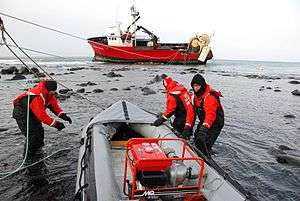

The Coast Guard occasionally publishes a list of statistics that summarizes their activities. Based on 2013 statistics, on an average day the United States Coast Guard will:[40]
- Conduct 109 search and rescue cases
- Save 10 lives
- Assist 192 people in distress
- Protect US$2.8 million in property
- Seize 169 pounds (77 kg) of marijuana and 306 pounds (139 kg) of cocaine with a street value of US$9.5 million
- Process 238 mariner licenses and documents
- Investigate 6 vessel casualties involving collisions or groundings
- Have underway small boats for 396 sorties/missions
- Fly 164 aircraft missions logging 324 hours
- Board 144 vessels of law enforcement interest
- Interdict and rescue 14 illegal immigrants at sea
- Open 8 new cases for marine violation of federal statutes
- Board 100 large vessels for port safety checks
- Conduct 20 commercial fishing vessel safety exams
- Respond to 20 oil or hazardous chemical spills totaling 2,800 US gal (11,000 l)
- Service 135 aids to navigation
- Monitor the transit of 2,509 commercial ships through U.S. ports
- Conduct 377 vessel safety checks
- Teach boating safety courses to 550 boaters
History
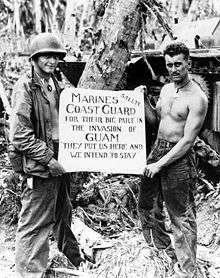
The Coast Guard traced its roots to the small fleet of vessels maintained by the United States Department of the Treasury beginning in the 1790s to enforce tariffs (an important source of revenue for the new nation). Secretary of the Treasury Alexander Hamilton lobbied Congress to fund the construction of ten cutters, which it did on 4 August 1790 (now celebrated as the Coast Guard's official birthday). Until the re-establishment of the Navy in 1798, these "revenue cutters" were the only naval force of the early United States. As such, the cutters and their crews frequently took on additional duties, including combating piracy, rescuing mariners in distress, ferrying government officials, and even carrying mail.[42] Initially not an organized federal agency at all, merely a "system of cutters," each ship operated under the direction of the customs officials in the port to which it was assigned. Several names, including "Revenue-Marine," were used as the service gradually becoming more organized. Eventually it was officially organized as the United States Revenue Cutter Service. In addition to its regular law enforcement and customs duties, revenue cutters served in combat alongside the Navy in various armed conflicts including the American Civil War.
The modern Coast Guard was created in 1915, when the Revenue Cutter Service merged with the U.S. Life-Saving Service. The Lighthouse Service and the Bureau of Marine Inspection and Navigation were absorbed by the Coast Guard 1939 and 1942 respectively.[43] [44] In 1967, the Coast Guard moved from the U.S. Department of the Treasury to the newly formed U.S. Department of Transportation, an arrangement that lasted until it was placed under the U.S. Department of Homeland Security in 2003 as part of legislation designed to more efficiently protect American interests following the terrorist attacks of 11 September 2001.
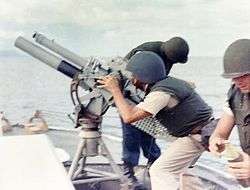
In times of war, the Coast Guard or individual components of it can operate as a service of the Department of the Navy. This arrangement has a broad historical basis, as the Coast Guard has been involved in wars as diverse as the War of 1812, the Mexican–American War, and the American Civil War, in which the cutter Harriet Lane fired the first naval shots attempting to relieve besieged Fort Sumter. The last time the Coast Guard operated as a whole within the Navy was in World War II, in all some 250,000 served in the Coast Guard during World War II.[45]
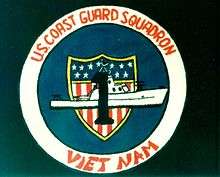
Coast Guard Squadron One, was a combat unit formed by the United States Coast Guard in 1965 for service during the Vietnam War. Placed under the operational control of the United States Navy, it was assigned duties in Operation Market Time. Its formation marked the first time since World War II that Coast Guard personnel were used extensively in a combat environment. The squadron operated divisions in three separate areas during the period of 1965 to 1970. Twenty-six Point-class cutters with their crews and a squadron support staff were assigned to the U.S. Navy with the mission of interdicting the movement of arms and supplies from the South China Sea into South Vietnam by Viet Cong and North Vietnam junk and trawler operators. The squadron also provided 81mm mortar naval gunfire support to nearby friendly units operating along the South Vietnamese coastline and assisted the U.S. Navy during Operation Sealords.
_shelling_targets_in_Vietnam_c1967.jpg)
Coast Guard Squadron Three, was a combat unit formed by the United States Coast Guard in 1967 for service during the Vietnam War.[46] Placed under the operational control of the United States Navy and based in Pearl Harbor. It consisted of five USCG High Endurance Cutters operating on revolving six-month deployments. A total of 35 High Endurance Cutters took part in operations from May 1967 to December 1971, most notably using their 5" guns to provide naval gunfire support missions.
Often units within the Coast Guard operate under Department of the Navy operational control while other Coast Guard units remain under the Department of Homeland Security.
Organization
The new Department of Homeland Security headquarters complex is on the grounds of the former St. Elizabeths Hospital in the Anacostia section of Southeast Washington, across the Anacostia River from former Coast Guard headquarters.[47]
The fiscal year 2016 budget request for the US Coast Guard was $9.96 billion.[48]
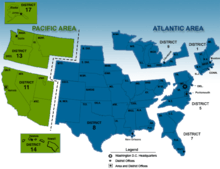
Districts and units
The Coast Guard's current district organization is divided into 9 districts. Their designations, district office and area of responsibility are as follows:
| District | Area | District Office | Area of Responsibility | Note |
|---|---|---|---|---|
| First District | Atlantic | Boston, Massachusetts | New England states, eastern New York and northern New Jersey | 1 |
| Fifth District | Atlantic | Portsmouth, Virginia | Pennsylvania, southern New Jersey, Delaware, Maryland, Virginia, and North Carolina | 5 |
| Seventh District | Atlantic | Miami, Florida | South Carolina, Georgia, eastern Florida, Puerto Rico, and the U.S. Virgin Islands | 7 |
| Eighth District | Atlantic | New Orleans, Louisiana | Western Rivers of the U.S. and the Gulf of Mexico | 8 |
| Ninth District | Atlantic | Cleveland, Ohio | Great Lakes | 9 |
| Eleventh District | Pacific | Alameda, California | California, Arizona, Nevada, and Utah | 11 |
| Thirteenth District | Pacific | Seattle, Washington | Oregon, Washington, Idaho and Montana | 13 |
| Fourteenth District | Pacific | Honolulu, Hawaii | Hawaii and Pacific territories | 14 |
| Seventeenth District | Pacific | Juneau, Alaska | Alaska | 17 |
Shore establishments

Shore establishment commands exist to support and facilitate the mission of the sea and air assets and Coastal Defense. U.S. Coast Guard Headquarters is located in Southeast Washington, DC. Other shore establishments are Coast Guard Sectors (which may include Coast Guard Bases), Coast Guard Stations, Coast Guard Air Stations, and the United States Coast Guard Yard. Training centers include the United States Coast Guard Academy, Training Center Petaluma, Training Center Cape May, Coast Guard Aviation Technical Training Center, Coast Guard Aviation Training Center Mobile, and Training Center Yorktown.
Personnel
The Coast Guard has a total workforce of 87,569.[2] The formal name for a uniformed member of the Coast Guard is "Coast Guardsman", irrespective of gender. "Coastie" is an informal term commonly used to refer to current or former Coast Guard personnel. In 2008, the term "Guardian" was introduced as an alternative but was later dropped. Admiral Robert J. Papp, Jr. stated that it was his belief that no Commandant had the authority to change what members of the Coast Guard are called as the term Coast Guardsman is found in Title 14 USC which established the Coast Guard in 1915.[49][Note 2]</ref> "Team Coast Guard" refers to the four components of the Coast Guard as a whole: Regular, Reserve, Auxiliary, and Coast Guard civilian employees.
Commissioned officers
Commissioned officers in the Coast Guard hold pay grades ranging from O-1 to O-10 and have the same rank structure as the Navy.[50][51] Officers holding the rank of ensign (O-1) through lieutenant commander (O-4) are considered junior officers, commanders (O-5) and captains (O-6) are considered senior officers, and rear admirals (O-7) through admirals (O-10) are considered flag officers. The Commandant of the Coast Guard and the Vice Commandant of the Coast Guard are the only members of the Coast Guard authorized to hold the rank of admiral.[52]
The Coast Guard does not have medical officers or chaplains of its own. Instead, chaplains from the U.S. Navy, as well as officers from the U.S. Public Health Service Commissioned Corps are assigned to the Coast Guard to perform chaplain-related functions and medical-related functions, respectively. These officers wear Coast Guard uniforms but replace the Coast Guard insignia with that of their own service.[53]
The Navy and Coast Guard share identical officer rank insignia except that Coast Guard officers wear a gold Coast Guard Shield in lieu of a line star or staff corps officer insignia.
| Ensign
(ENS) |
Lieutenant (junior grade) (LTJG) |
Lieutenant
(LT) |
Lieutenant commander (LCDR) |
Commander
(CDR) |
Captain
(CAPT) |
Rear admiral (lower half) (RDML) |
Rear admiral
(RADM) |
Vice admiral
(VADM) |
Admiral
(ADM) |
|---|---|---|---|---|---|---|---|---|---|
| O-1 | O-2 | O-3 | O-4 | O-5 | O-6 | O-7 | O-8 | O-9 | O-10 |
 |
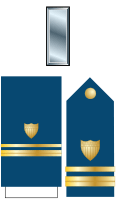 |
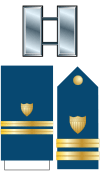 |
 |
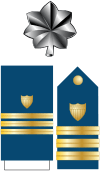 |
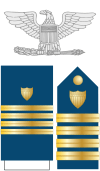 |
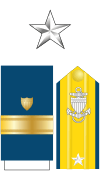 |
 |
 |
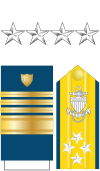 |
Warrant officers

Highly qualified enlisted personnel in pay grades E-6 through E-9 with a minimum of eight years experience can compete each year for appointment as warrant officers (WO). Successful candidates are chosen by a board and then commissioned as chief warrant officer two (CWO2) in one of twenty-one specialties. Over time, chief warrant officers may be promoted to chief warrant officer three (CWO3) and chief warrant officer four (CWO4). The ranks of warrant officer (WO1) and chief warrant officer five (CWO5) are not currently used in the Coast Guard. Chief warrant officers may also compete for the Chief Warrant Officer to Lieutenant Program. If selected, the warrant officer will be promoted to lieutenant (O-3E). The "E" designates over four years active duty service as a warrant officer or enlisted member and entitles the member to a higher rate of pay than other lieutenants.
| Chief warrant officer 2 | Chief warrant officer 3 | Chief warrant officer 4 |
|---|---|---|
| CWO-2 | CWO-3 | CWO-4 |
 |
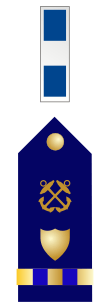 |
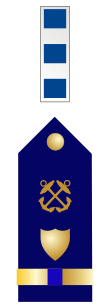 |
Enlisted personnel
Enlisted members of the Coast Guard have pay grades from E-1 to E-9 and also follow the same rank structure as the Navy. Enlisted members in pay grades of E-4 and higher are considered petty officers and follow career development paths very similar to those of Navy petty officers.
Petty officers in pay grade E-7 and higher are chief petty officers and must attend the Coast Guard Chief Petty Officer Academy, or an equivalent Department of Defense school, in order to be advanced to pay grade E-8. The basic themes of the school are:
- Professionalism
- Leadership
- Communications
- Systems thinking and lifelong learning
Enlisted rank insignia is also nearly identical to Navy enlisted insignia. The Coast Guard shield replacing the petty officer's eagle on collar and cap devices for petty officers or enlisted rating insignia for seamen qualified as a "designated striker". Group Rate marks (stripes) for junior enlisted members (E-3 and below) also follow Navy convention with white for seaman, red for fireman, and green for the airman. In a departure from the Navy conventions, all petty officers E-6 and below wear red chevrons and all chief petty officers wear gold
| Petty Officer Third Class
(PO3) |
Petty Officer Second Class
(PO2) |
Petty Officer First Class
(PO1) |
Chief Petty Officer
(CPO) |
Senior Chief Petty Officer
(SCPO) |
Master Chief Petty Officer
(MCPO) |
Command Master Chief Petty Officer
(CMC) |
Master Chief Petty Officer of the Coast Guard Reserve Force or Area/DCO/DCMS Command Master Chief Petty Officer | Master Chief Petty Officer of the Coast Guard
(MCPOCG) |
|---|---|---|---|---|---|---|---|---|
| E-4 | E-5 | E-6 | E-7 | E-8 | E-9 | E-9 with special pay | ||
| Seaman Recruit
(SR) |
Seaman Apprentice
(SA) |
Seaman
(SN) | ||||||
|---|---|---|---|---|---|---|---|---|
| E-1 | E-2 | E-3 | ||||||
 |
 |
 |
Training
Officer training
The U.S. Coast Guard Academy is a four-year service academy located in New London, Connecticut. Approximately 200 cadets graduate each year, receiving a Bachelor of Science degree and a commission as an ensign in the Coast Guard. Graduates are obligated to serve a minimum of five years on active duty. Most graduates are assigned to duty aboard Coast Guard cutters immediately after graduation, either as Deck Watch Officers (DWOs) or as Engineer Officers in Training (EOITs). Smaller numbers are assigned directly to flight training at Naval Air Station Pensacola, Florida or to shore duty at Coast Guard Sector, District, or Area headquarters units.
In addition to the Academy, prospective officers, who already hold a college degree, may enter the Coast Guard through Officer Candidate School (OCS), also located at the Coast Guard Academy. OCS is a 17-week course of instruction that prepares candidates to serve effectively as officers in the Coast Guard. In addition to indoctrinating students into a military lifestyle, OCS provides a wide range of highly technical information necessary to perform the duties of a Coast Guard officer.
Graduates of OCS are usually commissioned as ensigns, but some with advanced graduate degrees may enter as lieutenants (junior grade) or lieutenants. Graduating OCS officers entering active duty are required to serve a minimum of three years, while graduating reserve officers are required to serve four years. Graduates may be assigned to a cutter, flight training, a staff job, or an operations ashore billet.
OCS is the primary channel through which the Coast Guard enlisted grades ascend to the commissioned officer corps.
Lawyers, engineers, intelligence officers, military aviators holding commissions in other branches of the U.S. Armed Forces requesting interservice transfers to the Coast Guard, graduates of maritime academies, and certain other individuals may also receive an officer's commission in the Coast Guard through the Direct Commission Officer (DCO) program. Depending on the specific program and the background of the individual, the course is three, four or five weeks long. The first week of the five-week course is an indoctrination week. The DCO program is designed to commission officers with highly specialized professional training or certain kinds of previous military experience.
Unlike the other military services, the Coast Guard does not have a Reserve Officers' Training Corps (ROTC) program.
Recruit training
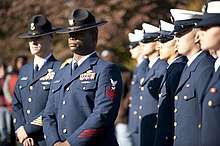
Newly enlisted personnel are sent to eight weeks of recruit training at Coast Guard Training Center Cape May in Cape May, New Jersey. New recruits arrive at Sexton Hall and remain there for three days of initial processing which includes haircuts, vaccinations, uniform issue, and other necessary entrance procedures. During this initial processing period, the new recruits are led by temporary company commanders. These temporary company commanders are tasked with teaching the new recruits how to march and preparing them to enter into their designated company. The temporary company commanders typically do not enforce any physical activity such as push ups or crunches. When the initial processing is complete, the new seaman recruits are introduced to their permanent company commanders who will remain with them until the end of training. There is typically a designated lead company commander and two support company commanders. The balance of the eight-week boot camp is spent in learning teamwork and developing physical skills. An introduction of how the Coast Guard operates with special emphasis on the Coast Guard's core values is an important part of the training.
The current nine Recruit Training Objectives are:
- Self-discipline
- Military skills
- Marksmanship
- Vocational skills and academics
- Military bearing
- Physical fitness and wellness
- Water survival and swim qualifications
- Esprit de corps
- Core values (Honor, Respect, and Devotion to Duty)
Service schools
Following graduation from recruit training, most members are sent to their first unit while they await orders to attend advanced training in Class "A" Schools. At "A" schools, Coast Guard enlisted personnel are trained in their chosen rating; rating is a Coast Guard and Navy term for enlisted skills synonymous with the Army's and Marine Corps' military occupation codes (MOS) and Air Force's Air Force Specialty Code (AFSC). Members who earned high ASVAB scores or who were otherwise guaranteed an "A" School of choice while enlisting may go directly to their "A" School upon graduation from Boot Camp.
Civilian personnel
The Coast Guard employs over 8,577 civilians in over two hundred different job types including Coast Guard Investigative Service special agents, lawyers, engineers, technicians, administrative personnel, tradesmen, and federal firefighters.[2][54] Civilian employees work at various levels in the Coast Guard to support its various missions.
Equipment
Cutters
.jpeg)
The Coast Guard operates 243 Cutters,[12] defined as any vessel more than 65 feet (20 m) long, that has a permanently assigned crew and accommodations for the extended support of that crew.[55]
- National Security Cutter (WMSL): Also known as the "Legend"-class, these are the Coast Guard's latest class of 418-foot (127 m) military defense maritime ship. At 418 ft. these are the largest USCG military cutters in active service. One-for-one Legend-class ships are replacing individually decommissioned 1960s Hamilton-class high endurance cutters. A total of eight were authorized and budgeted; as of 2015 three are in service, and three are under construction. In 2016 a ninth National Security Cutter was authorized by Congress.
- High Endurance Cutter (WHEC): The 378-foot (115 m) Hamilton-class cutters were commissioned in the late 1960s. Missions include law enforcement, search and rescue, and military defense. This aged class of 12 are being individually decommissioned and replaced on a one-for one basis by the new Legend-class National Security Cutters.
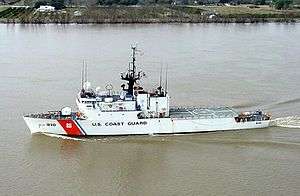
- Medium Endurance Cutter (WMEC): These are mostly the 210-foot (64 m) Reliance-class, and the 270-foot (82 m) Famous-class cutters, although the 283-foot (86 m) Alex Haley also falls into this category. Primary missions are law enforcement, search and rescue, and military defense.
- Polar-class icebreaker (WAGB): There are three WAGB's used for icebreaking and research though only two, the heavy 399-foot (122 m) Polar Star and the newer medium class 420-foot (130 m) Healy, are active.[56][57][58][59] Polar Sea is located in Seattle, Washington but is not currently in active service. The icebreakers are being replaced with new heavy icebreakers under the Polar icebreaker program.
- USCGC Mackinaw: A 240-foot (73 m) heavy icebreaker built for operations on the Great Lakes.
- USCGC Eagle: A 295-foot (90 m) sailing barque used as a training ship for Coast Guard Academy cadets and Coast Guard officer candidates. She was originally built in Germany as Horst Wessel, and was seized by the United States as a prize of war in 1945.[60][61]
- Seagoing Buoy Tender (WLB): These 225-foot (69 m) ships are used to maintain aids to navigation and also assist with law enforcement and search and rescue.
- Coastal Buoy Tender (WLM): The 175-foot (53 m) Keeper-class coastal buoy tenders are used to maintain coastal aids to navigation.

- Sentinel-class cutter (WPC): The 154-foot (47 m) Sentinel-class, also known by its program name, the "Fast Response Cutter"-class and is used for search and rescue work and law enforcement.
- Bay-class icebreaking tug (WTGB): 140-foot (43 m) icebreakers used primarily for domestic icebreaking missions. Other missions include search and rescue, law enforcement, and aids to navigation maintenance.[62]

- Patrol Boats (WPB): There are two classes of WPBs currently in service; the 110-foot (34 m) Island-class patrol boats and the 87-foot (27 m) Marine Protector-class patrol boats[63][64]
Boats


The Coast Guard operates about 1,650 boats,[12] defined as any vessel less than 65 feet (20 m) long, which generally operate near shore and on inland waterways.
The Coast Guard boat fleet includes:
- Motor Lifeboat (MLB): The Coast Guard's 47-foot (14 m) primary heavy-weather boat used for search and rescue as well as law enforcement and homeland security.
- Response Boat – Medium (RB-M): A new multi-mission 45-foot (14 m) vessel intended to replace the 41-foot (12 m) utility boat. 170 planned
- Special Purpose Craft – Near Shore Lifeboat: Only 2 built. Shallow draft, 42-foot (13 m) lifeboat substituted for the 47-foot (14 m) Motor Life Boat, based at Chatham, Massachusetts[65]
- Deployable Pursuit Boat (DPB): A 38-foot (12 m) launch capable of pursuing fast cocaine smuggling craft.
- Long Range Interceptor (LRI): A 36-foot (11 m) high-speed launch that can be launched from the stern ramps of the larger Deepwater cutters.
- Aids to Navigation Boats (TANB/BUSL/ANB/ANB): Various designs ranging from 26 to 55 feet (7.9 to 16.8 m) used to maintain aids to navigation.
- Special Purpose Craft – Law Enforcement (SPC-LE): Intended to operate in support of specialized law enforcement missions, utilizing three 300 horsepower (220 kW) Mercury Marine engines. The SPC-LE is 33 feet (10 m) long and capable of speeds in excess of 50 knots (93 km/h; 58 mph) and operations more than 30 miles (48 km) from shore.
- Response Boat – Small (RB-S): A 25-foot (7.6 m) high-speed boat, for a variety of missions, including search and rescue, port security and law enforcement duties.
- Transportable Port Security Boat (TPSB): A 25-foot (7.6 m) well-armed boat used by Port Security Units for force protection.
- SPC-SW Special Purpose Craft, Shallow-water: 24 feet (7.3 m)
- Over-the-Horizon (OTH) boat: A 23-foot (7.0 m) rigid hull inflatable boat used by medium and high endurance cutters and specialized units.
- Short Range Prosecutor (SRP): A 23-foot (7.0 m) rigid hull inflatable boat that can be launched from a stern launching ramp on the National Security Cutters.
Aircraft

.jpg)

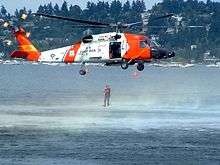
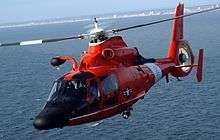
The Coast Guard operates approximately 201 fixed and rotary wing aircraft[12] from 24 Coast Guard Air Stations throughout the contiguous United States, Alaska, Hawaii, and Puerto Rico. Most of these air stations are tenant activities at civilian airports, several of which are former Air Force Bases and Naval Air Stations, although several are also independent military facilities. Coast Guard Air Stations are also located on active Naval Air Stations, Air National Guard bases, and Army Air Fields.
Coast Guard aviators receive Primary (fixed-wing) and Advanced (fixed or rotary-wing) flight training with their Navy and Marine Corps counterparts at NAS Whiting Field, Florida, and NAS Corpus Christi, Texas, and are considered Naval Aviators. After receiving Naval Aviator Wings, Coast Guard pilots, with the exception of those slated to fly the HC-130, report to U.S. Coast Guard Aviation Training Center, Mobile, Alabama to receive 6–12 weeks of specialized training in the Coast Guard fleet aircraft they will operate. HC-130 pilots report to Little Rock AFB, Arkansas, for joint C-130 training under the auspices of the 314th Airlift Wing of the U.S. Air Force.
Fixed-wing aircraft operate from Air Stations on long-duration missions. Helicopters operate from Air Stations and can deploy on a number of different cutters. Helicopters can rescue people or intercept vessels smuggling migrants or narcotics. Since the terrorist attacks of 11 September 2001, the Coast Guard has developed a more prominent role in national security and now has armed helicopters operating in high-risk areas for the purpose of maritime law enforcement and anti-terrorism.
The Coast Guard is now developing an unmanned aerial vehicle (UAV) program that will utilize the MQ-9 Reaper platform for homeland security and search/rescue operations. To support this endeavor, the Coast Guard has partnered with the Navy and U.S. Customs and Border Protection to study existing/emerging unmanned aerial system (UAS) capabilities within their respective organizations. As these systems mature, research and operational experience gleaned from this joint effort will enable the Coast Guard to develop its own cutter and land-based UAS capabilities.
| Type | Manufacturer | Origin | Class | Role | Introduced | In service[66] | Notes |
|---|---|---|---|---|---|---|---|
| C-27J Spartan | Alenia Aeronautica | U.S. Italy |
Turboprop | Search and rescue | 2014 | 14 | Former Air Force aircraft, acquired in return for the release of seven HC-130H aircraft to the United States Forest Service for use as aerial tankers. |
| C-37A | Gulfstream | U.S. | Jet | Priority Airlift | 1998 | 1 | Priority Airlift for high-ranking members of the Department of Homeland Security and U.S. Coast Guard. |
| C-37B | Gulfstream | U.S. | Jet | Priority Airlift | 2017 | 1 | Priority Airlift for high-ranking members of the Department of Homeland Security and U.S. Coast Guard. |
| HC-130H Hercules | Lockheed Martin | U.S. | Turboprop | Search and rescue | 1974 | 14 | Most have been removed from service and are being replaced by HC-130J aircraft. Seven were turned over to the United States Forest Service to be converted to aerial firefighting tankers. |
| HC-130J Hercules | Lockheed Martin | U.S. | Turboprop | Search and rescue | 2003 | 12 | More on order, currently being manufactured to replace HC-130H. |
| HC-144A Ocean Sentry | Airbus | U.S. Spain |
Turboprop | Search and rescue | 2009 | 15 | |
| HC-144B Minotaur | Airbus | U.S. Spain |
Turboprop | Search and rescue | 2016 | 3 | Minotaur upgrade of HC-144A aircraft includes advance navigation and search and rescue equipment. |
| MH-60T Jayhawk | Sikorsky | U.S. | Helicopter | Medium Range Recovery (MRR) | 1990 | 42 | will remain in service until 2027 |
| MH-65D Dolphin | Eurocopter | U.S. France |
Helicopter | Short Range Recovery (SRR) | 1984 | 95 | |
| MH-65E Dolphin | Eurocopter | U.S. France |
Helicopter | Short Range Recovery (SRR) | 1984 | 3 | Upgraded version of MH-65D with advanced avionics and search and rescue equipment |
Weapons

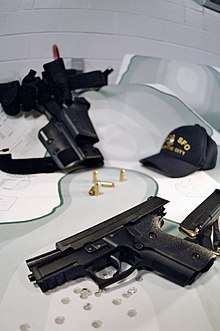
Naval guns
Most Coast Guard Cutters have one or more naval gun systems installed, including:
- The Oto Melara 76 mm, a radar-guided computer controlled gun system that is used on both Medium and High Endurance Cutters. The 3-inch gun's high rate of fire and availability of specialized ammunition make it a multi-purpose gun capable of anti-shipping, anti-aircraft, ground support and short-range anti-missile defense.
- The MK 110 57mm gun, a radar-guided computer controlled variant of the Bofors 57 mm gun. It is used on the Legend-class cutter, also known as the National Security Cutter (NSC). It is a multi-purpose gun capable of anti-shipping, anti-aircraft, and short-range anti-missile defense. The stealth mount has a reduced radar profile. Also, the gun has a small radar mounted on the gun barrel to measure muzzle velocity for fire control purposes and can change ammunition types instantly due to a dual-feed system. It can also be operated/fired manually using a joystick and video camera (mounted on gun).
- The Mk 38 Mod 0 weapons system consists of an M242 Bushmaster 25mm chain gun and the Mk 88 Mod 0 machine gun mount. A manned system, its gyro-stabilization compensates for the pitching deck. It provides ships with defensive and offensive gunfire capability for the engagement of a variety of surface targets. Designed primarily as a close-range defensive measure, it provides protection against patrol boats, floating mines, and various shore-based targets.
- The Mk 38 Mod 2 weapons system is a remotely operated Mk 38 with an electronic optical sight, laser range-finder, FLIR, a more reliable feeding system, all of which enhance the weapon systems capabilities and accuracy.
- The Phalanx CIWS (pronounced "sea-wiz") is a close-in weapon system for defense against aircraft and anti-ship missiles. it can also be used against a variety of surface targets. Consisting of a radar-guided 20 mm 6-barreled M61 Vulcan cannon mounted on a swiveling base, it is used on the Coast Guard's High Endurance Cutters. This system can operate autonomously against airborne threats or may be manually operated with the use of electronic optical sight, laser range-finder and FLIR systems against surface targets.
- The Sea PROTECTOR MK50 is a remotely controlled gyro-stabilized M2 .50 caliber heavy machine gun. The sight package includes a daylight video camera, a thermal camera and an eye-safe laser rangefinder operated by a joystick. It is also furnished with a fully integrated fire control system that provides ballistic correction. The Mk50s are used on only four Marine Protector-class Cutters, the USCGC Sea Fox (WPB-87374), USCGC Sea Devil (WPB-87368), USCGC Sea Dragon (WPB-87367) and USCGC Sea Dog (WPB-87373)
Small arms and light weapons
The U.S. Coast Guard uses a wide variety of small arms and light weapons. Handguns, shotguns, and rifles are used to arm boat crew and boarding team members and machine guns are mounted aboard cutters, boats, and helicopters.
Small arms and light weapons arms include:
- M9 9mm pistol
- SIG Sauer P229R DAK .40 S&W pistol
- Remington M870P 12 gauge shotgun
- M16A2 rifle
- M4 carbine
- Mk 18 carbine
- M14 Tactical rifle
- Mk 11 (KAC SR-25)
- Mk 11 Mod 2 precision rifle
- FN M240 machine gun
- M2 .50 caliber heavy machine gun
- Mk 19 40mm grenade launcher[67]
- Barrett M107 .50-caliber rifle, used by marksmen from the Helicopter Interdiction Tactical Squadron and Law Enforcement Detachments to disable the engines on fleeing boats.
Symbols
Core values
The Coast Guard, like the other armed services of the United States, has a set of core values that serve as basic ethical guidelines for all Coast Guard active duty, reservists, auxiliarists, and civilians. The Coast Guard Core Values are:
Honor: Integrity is our standard. We demonstrate uncompromising ethical conduct and moral behavior in all of our personal actions. We are loyal and accountable to the public trust.
Respect: We value our diverse workforce. We treat each other with fairness, dignity, and compassion. We encourage individual opportunity and growth. We encourage creativity through empowerment. We work as a team.
Devotion to Duty: We are professionals, military and civilian, who seek responsibility, accept accountability, and are committed to the successful achievement of our organizational goals. We exist to serve. We serve with pride.— Coast Guard Core Values[68]
The Guardian Ethos
In 2008, the Coast Guard introduced the Guardian Ethos. As the Commandant, Admiral Allen noted in a message to all members of the Coast Guard: [The Ethos] "defines the essence of the Coast Guard," and is the "contract the Coast Guard and its members make with the nation and its citizens."[69]
The Coast Guard Ethos
In an ALCOAST message effective 1 December 2011 the Commandant, Admiral Papp, directed that the language of Guardian Ethos be superseded by the Coast Guard Ethos in an effort to use terminology that would help with the identity of personnel serving in the Coast Guard.[70] The term Coast Guardsman is the correct form of address used in Title 14 USC and is the form that has been used historically. This changed the line in the Guardian Ethos "I am a Guardian." to become "I am a Coast Guardsman."[71]
The Ethos is:
I am a Coast Guardsman.
I serve the people of the United States.
I will protect them.
I will defend them.
I will save them.
I am their shield.
For them I am Semper Paratus.
I live the Coast Guard core values.
I am proud to be a Coast Guardsman.
We are the United States Coast Guard.— The Coast Guard Ethos[72]
Creed of the United States Coast Guardsman
The "Creed of the United States Coast Guardsman" was written by Vice Admiral Harry G. Hamlet, who served as Commandant of the Coast Guard from 1932 to 1936.[73]
I am proud to be a United States Coast Guardsman.
I revere that long line of expert seamen who by their devotion to duty and sacrifice of self have made it possible for me to be a member of a service honored and respected, in peace and in war, throughout the world.
I never, by word or deed, will bring reproach upon the fair name of my service, nor permit others to do so unchallenged.
I will cheerfully and willingly obey all lawful orders.
I will always be on time to relieve, and shall endeavor to do more, rather than less, than my share.
I will always be at my station, alert and attending to my duties.
I shall, so far as I am able, bring to my seniors solutions, not problems.
I shall live joyously, but always with due regard for the rights and privileges of others.
I shall endeavor to be a model citizen in the community in which I live.
I shall sell life dearly to an enemy of my country, but give it freely to rescue those in peril.
With God's help, I shall endeavor to be one of His noblest Works...
A UNITED STATES COAST GUARDSMAN.— Creed of the United States Coast Guardsman[74]
"You have to go out, but you don't have to come back!"
This unofficial motto of the Coast Guard dates to an 1899 United States Lifesaving Service regulation, which states in part: "In attempting a rescue, ... he will not desist from his efforts until by actual trial, the impossibility of effecting a rescue is demonstrated. The statement of the keeper that he did not try to use the boat because the sea or surf was too heavy will not be accepted, unless attempts to launch it were actually made and failed."[75]
Coast Guard Ensign

.png)
The Coast Guard Ensign (flag) was first flown by the Revenue Cutter Service in 1799 to distinguish revenue cutters from merchant ships. A 1 August 1799 order issued by Secretary of the Treasury, Oliver Wolcott, Jr. specified that the Ensign would be "sixteen perpendicular stripes (for the number of states in the United States at the time), alternate red and white, the union of the ensign to be the arms of the United States in a dark blue on a white field."[76]
This ensign became familiar in American waters and served as the sign of authority for the Revenue Cutter Service until the early 20th century. The ensign was originally intended to be flown only on revenue cutters and boats connected with the Customs Service but over the years it was found flying atop custom houses as well, and the practice became a requirement in 1874. On 7 June 1910, President William Howard Taft issued an Executive Order adding an emblem to (or "defacing") the ensign flown by the Revenue cutters to distinguish it from what is now called the Customs Ensign flown from the custom houses. The emblem was changed to the official seal of the Coast Guard in 1927.[77][78]
The purpose of the ensign is to allow ship captains to easily recognize those vessels having legal authority to stop and board them. It is flown only as a symbol of law enforcement authority and is never carried as a parade standard.[79]
Coast Guard Standard
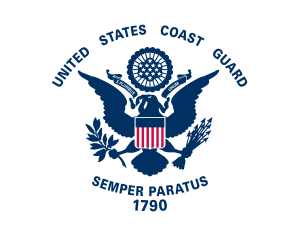
The Coast Guard Standard is used in parades and carries the battle honors of the Coast Guard. It was derived from the jack of the Coast Guard ensign which was flown by revenue cutters. The emblem is a blue eagle from the coat of arms of the United States on a white field. Above the eagle are the words "UNITED STATES COAST GUARD" below the eagle is the motto, "SEMPER PARATUS" and the inscription "1790."
Service Mark ("Racing Stripe")
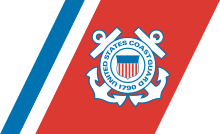
The racing stripe is borne by Coast Guard cutters, aircraft, and many boats. First used and placed into official usage as of April 6, 1967, it consists of a narrow blue stripe, a narrow white stripe between, and a broad CG red bar with the Coast Guard shield centered.[4][80] Red-hulled icebreaker cutters and most HH-65/MH-65 helicopters (i.e., those with a red fuselage) bear a narrow blue stripe, a narrow empty stripe the color of the fuselage (an implied red stripe), and broad white bar, with the Coast Guard shield centered. Conversely, black-hulled cutters (such as buoy tenders and inland construction tenders) use the standard racing stripe. Auxiliary vessels maintained by the Coast Guard also carry the Racing Stripe, but in inverted colors (i.e., broad blue stripe with narrow white and CG red stripes) and the Auxiliary shield.
The Racing Stripe, officially known as the Service Mark, was designed in 1964 by the industrial design office of Raymond Loewy Associates to give the Coast Guard a distinctive, modern image. Loewy had designed the colors for the Air Force One fleet for Jackie Kennedy. President Kennedy was so impressed with his work, he suggested that the entire Federal Government needed his make-over and suggested that he start with the Coast Guard.[81][82] The stripes are canted at a 64 degree angle, coincidentally the year the Racing Stripe was designed.[83]
Similar Racing Stripe designs have been adopted for the use of other coast guards and maritime authorities and many other law enforcement and rescue agencies.
Uniforms

History
For most of the Coast Guard's history its uniforms largely mirrored the style of U.S. Navy uniforms, distinguishable only by their insignia. In 1974, the initial version of the current Coast Guard Service Dress Blue uniform was introduced. This represented a departure from many common conventions in naval uniforms. It dispensed with the sailor suit and created a single service dress uniform for officers and enlisted personnel.[84]
Service uniforms
The Service Dress Blue uniform consists of a blue four-pocket single breasted jacket, matching trousers, and a tie of the same shade as the jacket. It is usually worn with a light blue collared shirt with two button-flap chest pockets and shoulder loops, but for Lee formal uses a plain white collared shirt is used, known as Service Dress Blue Alpha. Either the garrison cap or combination cap may be worn. Officer and enlisted rank insignia are sewn onto the jacket sleeve in the same manner as Navy uniforms.[85]
The Service Dress White "choker" uniforms for officers are identical to those worn by U.S. Navy officers (aside from service-specific buttons, insignia and sword design). These are typically used for formal parade and change-of-command ceremonies. For similar occasions the enlisted members wear Tropical Blue, Service Dress Blue or Full Dress Blue.[85]
The Tropical Blue uniform, worn in warm weather, omits the jacket and tie, and features a short-sleeved, light blue shirt with rank insignia on shoulder boards for officers, and pin-on collar insignia for petty officers. The Tropical Blue uniform may be worn year-round for general office wear and for visits between commands. It may be worn in lieu of the SDB uniform, but not to functions where civilian dress is coat and tie.[85]
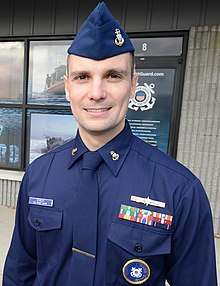
The Winter Dress Blue uniform consists of a long-sleeve dark blue shirt of the same color as the Service Dress Blue jacket and trousers, without shoulder loops. It is worn with the blue necktie and rank insignia pins on the collar.[85]
All blue service and dress uniforms are worn with a black, plain-toe derby shoe (incorrectly referred to as "oxford shoes" in Coast Guard Uniform Regulations) or, optionally, black pumps or flats for females. Patent leather versions are authorized. White derby shoes are worn with the dress white uniforms.[85]
Dress uniforms

The Full Dress Blue uniform is essentially the same as Service Dress Blue Alpha, except that it is worn with a full-size medals instead of ribbons, white gloves, and (for officers) a sword. Similarly, the Full Dress White uniform consists of the Service Dress White with the same accoutrements as the Full Dress Blue uniform.[85]

Despite the transition to distinctive uniforms for everyday wear in the 1970s, Navy-style dress uniforms were retained. The dinner dress uniforms worn for formal (black tie) evening ceremonies are also identical to those of the Navy, aside from Coast Guard-specific insignia. As in the Navy, these uniforms are required for officers, but optional for enlisted members. Due to the expense of these uniforms and the fact that they are rarely called-for, few junior enlisted members purchase them.[85]
Working uniforms

The current working uniform of the Coast Guard is the Operational Dress Uniform (ODU). The ODU may be worn year-round primarily as a field utility and watchstanding uniform, but may also be worn in an office environment where appropriate. The ODU is similar, both in function and style, to the old-style Battle Dress Uniform previously worn by all branches of the U.S. Armed Forces. However, the ODU is in a solid dark blue with no camouflage pattern and does not have lower pockets on the blouse. The first generation ODU, in service from 2004 to 2012, was worn with the blouse tucked into the trousers. The second generation ODU is worn with the blouse untucked and has black Coast Guard insignia embroidered on the right breast pocket as well as the side pockets of the trousers.[85]
The standard footwear is a black composite-toe boot. Brown boat shoes may be allowed for daily wear aboard ship unless boots are required for safety reasons.[85]
A standard baseball-style cap embroidered in gold block lettering with "U.S. Coast Guard," is the standard headgear. Units may also authorize ball caps with the unit name embroidered for wear while at the unit.[85]
For cold weather, the standard outerwear worn with ODU is a "Foul Weather Parka," which comes with a removable liner that may be worn as a stand-alone lightweight jacket. The Foul Weather Parka replaced several more traditional styles of outerwear (notably the reefer jacket) as the only authorized outerwear for the ODU, and is also permitted with several service uniform styles. A "Cold Weather Cap" in the style of an ushanka is also authorized for extreme cold environments.[85]
The ODU's simple style and practicality as a working uniform has led the U.S. Public Health Service and the NOAA Corps to adopt ODU variants as standard working uniforms. Some Navy personnel also advocated adoption of the ODU as a standard shipboard uniform for the Navy, rather than the unpopular Navy Working Uniform Type I.
Coast Guard personnel serving in expeditionary combat units such as Port Security Units or Law Enforcement Detachments, and Coast Guard personnel deployed overseas (e.g. as part of PATFORSWA) may wear the Navy Working Uniform Type III with distinctive Coast Guard insignia.[85]
Special uniform situations
Company commanders (the Coast Guard's equivalent of drill sergeants) at Training Center Cape May wear the traditional Smokey Bear-style campaign hat.
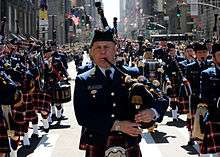
The Coast Guard Pipe Band, a special musical unit composed of active, reserve and auxiliary members, wears a modified form of highland dress, including kilt and sporran. It is, along with the Band of the Air Force Reserve Pipe Band, one of only two kilted units in the United States military, excluding those maintained by state defense forces and service academies. The band's kilt is patterned in the official U.S. Coast Guard tartan, which is registered with the Scottish Register of Tartans and based on the Hamilton tartan (in honor of the founder of the Revenue-Marine, Alexander Hamilton).[86]
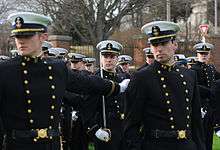
Cadets at the U.S. Coast Guard Academy wear standard Coast Guard uniforms, but also wear two different styles of parade dress uniforms, similar to those worn by Midshipmen at the U.S. Naval Academy. Full Dress Blue (B) consists of black blouses with banded collars and double rows of buttons, worn with matching black trousers and a white peaked hat. Full Dress Blue (A) substitutes white trousers in lieu of black.[87]
Coast Guard Reserve

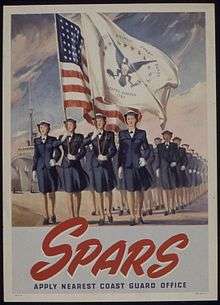
The United States Coast Guard Reserve is the reserve military force of the Coast Guard.[88] The Coast Guard Reserve was founded on 19 February 1941. The Coast Guard has 8700 reservists[2] who normally drill two days a month and an additional 12 days of active duty each year, although many perform additional drill and active duty periods, to include those mobilized to extended active duty. Coast Guard reservists possess the same training and qualifications as their active duty counterparts, and as such, can be found augmenting active duty Coast Guard units every day.
During the Vietnam War and shortly thereafter, the Coast Guard considered abandoning the reserve program, but the force was instead reoriented into force augmentation, where its principal focus was not just reserve operations, but to add to the readiness and mission execution of every-day active duty personnel.
Since 11 September 2001, reservists have been activated and served on tours of active duty, to include deployments to the Persian Gulf and also as parts of Department of Defense combatant commands such as the U.S. Northern and Central Commands. Coast Guard Port Security Units are entirely staffed with reservists, except for five to seven active duty personnel. Additionally, most of the staffing the Coast Guard provides to the Navy Expeditionary Combat Command are reservists.
The Reserve is managed by the Assistant Commandant for Reserve, Rear Admiral Todd C. Wiemers, USCG.
Women in the Coast Guard
In 1918, twin sisters Genevieve and Lucille Baker of the Naval Coastal Defense Reserve became the first uniformed women to serve in the Coast Guard.[89] Later, United States Coast Guard Women's Reserve (SPARS) was created on 23 November 1942 with the signing of Public Law 773 by President Franklin Delano Roosevelt.[90] The name is a contraction of the Coast Guard motto Semper Paratus, meaning "Always Ready" in Latin. The name also refers to a spar in nautical usage. Like the other women's reserves such as the Women's Army Corps and the WAVES, it was created to free men from stateside service in order to fight overseas. Its first director was Captain Dorothy C. Stratton who is credited with creating the name for the organization.[91] The cutter USCGC Spar is named for the SPARS.
Coast Guard Auxiliary
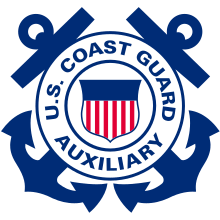
The United States Coast Guard Auxiliary is the civilian volunteer uniformed auxiliary service of the United States Coast Guard, established on 23 June 1939 by an act of Congress as the United States Coast Guard Reserve, it was re-designated as the United States Coast Guard Auxiliary on 19 February 1941. It works within the Coast Guard in carrying out its noncombatant and non-law enforcement missions.[92] Auxiliarists are subject to direction from the Commandant of the Coast Guard making them unique among all federal volunteers (e.g. Air Force's Civil Air Patrol and FBI's InfraGard); they are not a separate organization, but an integral part of the Coast Guard. As of 2018, there were approximately 24,000 members of the U.S. Coast Guard Auxiliary.[93]
The Coast Guard has assigned primary responsibility for many recreational boating safety tasks to the Auxiliary, including public boating safety education and voluntary Vessel Safety Checks (formerly called Courtesy Examinations).[94] Additionally, Auxiliarists use their own vessels, boats, and aircraft (once registered as Coast Guard facilities) to conduct safety patrols, aid in search and rescue missions, and perform other tasks on behalf of the Coast Guard.
Prior to 1997, Auxiliarists were largely limited to activities supporting recreational boating safety. In 1997, however, new legislation authorized the Auxiliary to participate in any and all Coast Guard missions except direct military and direct law enforcement.[95] Auxiliarists may directly augment active duty Coast Guard personnel in non-combat, non-law enforcement roles (e.g. radio communications watch stander, interpreter, cook, etc.) and may assist active duty personnel in inspecting commercial vessels and maintaining aids-to-navigation. Auxiliarists may support the law enforcement and homeland security missions of the Coast Guard but may not directly participate (make arrests, etc.), and Auxiliarists are not permitted to carry a weapon while serving in any Auxiliary capacity.
Deployable Operations Group
The Deployable Operations Group (DOG) was a Coast Guard command established in July 2007. The DOG established a single command authority to rapidly provide the Coast Guard, Department of Homeland Security, Department of Defense, Department of Justice and other interagency operational commanders adaptive force packages drawn from the Coast Guard's deployable specialized force units. The DOG was disestablished on 22 April 2013 and its deployable specialized forces (DSF) units were placed under the control of the Atlantic and Pacific Area Commanders.[96]
The planning for the unit began after the terrorist attacks of 11 September 2001, and culminated with its formation on 20 July 2007. Its missions included maritime law enforcement, anti-terrorism, port security, pollution response, and diving operations.
There were over 25 specialized units within the Deployable Operations Group including the Maritime Security Response Team, Maritime Safety and Security Teams, Law Enforcement Detachments, Port Security Units, the National Strike Force, and Regional Dive Lockers. The DOG also managed Coast Guard personnel assigned to the Navy Expeditionary Combat Command and was involved in the selection of Coast Guard candidates to attend Navy BUD/S and serve with Navy SEAL Teams.[97]
Medals and honors
One Coast Guardsman, Douglas Albert Munro, has earned the Medal of Honor, the highest military award of the United States.[98] Fifty five Coast Guardsmen have earned the Navy Cross and numerous men and women have earned the Distinguished Flying Cross.
The highest peacetime decoration awarded within the Coast Guard is the Homeland Security Distinguished Service Medal; prior to the transfer of the Coast Guard to the Department of Homeland Security, the highest peacetime decoration was the Department of Transportation Distinguished Service Medal. The highest unit award available is the Presidential Unit Citation.
In wartime, members of the Coast Guard are eligible to receive the Navy version of the Medal of Honor. A Coast Guard Medal of Honor is authorized but has not yet been developed or issued.
In May 2006, at the Change of Command ceremony when Admiral Thad Allen took over as Commandant, President George W. Bush awarded the entire Coast Guard, including the Coast Guard Auxiliary, the Coast Guard Presidential Unit Citation with hurricane device, for its efforts during and after Hurricane Katrina and Tropical Storm Rita.
Notable Coast Guardsmen
Numerous celebrities have served in the Coast Guard including tennis player Jack Kramer, golfer Arnold Palmer, All Star baseball player Sid Gordon, boxer Jack Dempsey; musicians Kai Winding, Rudy Vallee,[99] Derroll Adams, and Tom Waits; actors Buddy Ebsen, Sid Caesar, Victor Mature, Richard Cromwell, Alan Hale, Jr., William Hopper, Beau Bridges, Jeff Bridges, Cesar Romero; author Alex Haley; and Senator Claiborne Pell.
Vice Admiral Thad Allen in 2005 was named Principal Federal Officer to oversee recovery efforts in the Gulf Region after Hurricane Katrina. After promotion to Admiral, on the eve of his retirement as Commandant, Allen again received national visibility after being named National Incident Commander overseeing the response efforts of the Deepwater Horizon oil spill.
Former Coast Guard officers have been appointed to numerous civilian government offices. After retiring as Commandant of the Coast Guard in 2002, Admiral James Loy went on to serve as United States Deputy Secretary of Homeland Security. After their respective Coast Guard careers, Carlton Skinner served as the first Civilian Governor of Guam; G. William Miller, 65th Secretary of the Treasury, and retired Vice Admiral Harvey E. Johnson, Jr. served as Deputy Administrator and Chief Operating Officer of the Federal Emergency Management Agency (FEMA) under President George W. Bush. Rear Admiral Stephen W. Rochon was appointed by President George W. Bush to serve as the Director of the Executive Residence and White House Chief Usher, beginning service on 12 March 2007, and continued to serve in the same capacity under President Barack Obama.
Two Coast Guard aviators, Commander Bruce E. Melnick and Captain Daniel C. Burbank, have served as NASA astronauts.
Signalman First Class Douglas Albert Munro was awarded the Medal of Honor posthumously, and is the only Coast Guardsman to ever receive this honor.[98]
Organizations
Coast Guard Aviation Association
Those who have piloted or flown in Coast Guard aircraft under official flight orders may join the Coast Guard Aviation Association which was formerly known as the "Ancient Order of the Pterodactyl" ("Flying Since the World was Flat").
The Ancient Albatross Award is presented to the active duty USCG member who qualified as an aviator earlier than any other person who is still serving. Separate enlisted and officer awards are given.[100][101]
Coast Guard CW Operators Association
The Coast Guard CW Operators Association (CGCWOA) is a membership organization comprising primarily former members of the United States Coast Guard who held the enlisted rating of Radioman (RM) or Telecommunications Specialist (TC), and who employed International Morse Code (CW) in their routine communications duties on Coast Guard cutters and at shore stations.[102]
USCG Chief Petty Officers Association
Members of this organization unite to assist members and dependents in need, assist with Coast Guard recruiting efforts, support the aims and goals of the Coast Guard Chief Petty Officers Academy, keep informed on Coast Guard matters, and assemble for social amenities; and include Chief, Senior Chief, and Master Chief Petty Officers, active, reserve and retired. Membership is also open to all Chief Warrant Officers and Officers who have served as a Chief Petty Officer.[103]
USCG Chief Warrant and Warrant Officers Association (CWOA)
Established in 1929, the Chief Warrant and Warrant Officers Association, United States Coast Guard (CWOA) represents Coast Guard warrant and chief warrant officers (active, reserve and retired) to the Congress, White House and the Department of Homeland Security. Additionally, the association communicates with the Coast Guard leadership on matters of concern to Coast Guard chief warrant officers.[104]
In popular culture
The U.S. Coast Guard maintains a Motion Picture and Television Office (MOPIC) in Hollywood, California, along with its sister services at the Department of Defense dedicated to enhancing public awareness and understanding of the Coast Guard, its people, and its missions through a cooperative effort with the entertainment industry.[105][106]
In film
- Swamp Fire (1946) features the Coast Guard bar pilots in Louisiana.
- Fighting Coast Guard (1951), depicts Coast Guard trained to help win WWII.[106]
- Onionhead (1958), is a comedy-drama film set aboard the (fictional) Coast Guard buoy tender USCGC Periwinkle at the start of World War II. The film was shot at Warner Bros.' studio in Burbank, California; location shooting for the film took place at the Coast Guard station in Alameda, California, and aboard USCGC Yamacraw (WARC-333), at Coast Guard Base Yerba Buena Island.
- The Boatniks (1970), is a light-hearted depiction of a Coast Guard unit tasked with supervising recreational boaters on the California coast.
- The Island (1980), latter-day Caribbean pirates capture the (fictional) cutter USCGC New Hope. Filming was done on USCGC Dauntless.[106]
- Bad Boys II (2003), depicts counter-drug helicopters from the Helicopter Interdiction Tactical Squadron (HITRON).[106]
- The Guardian (2006), depicts the Aviation Survival Technician (AST) program.
- Pain & Gain (2013), starring Dwayne Johnson and Mark Wahlberg, depicted the Coast Guard Deployable Operations Group in action.[106]
- The Finest Hours (2016), A film portraying the rescue of the crew of SS Pendleton by coxswain Bernard C. Webber and the three other crewmen of Coast Guard Motor Lifeboat CG 36500.[106]
On television
The Coast Guard has been featured in several television series, including:
- Coast Guard was a syndicated television series that aired for three seasons from 1995 to 1997 in the United States as well as overseas, where it was called Sea Rescue. The series followed Coast Guard personnel as they performed their missions.[107][108][109]
- Coast Guard Alaska: Search and Rescue, a series on The Weather Channel that features a Coast Guard search-and-rescue unit based in Kodiak, Alaska. Several series have spun off the original to focus on units based in Cape Disappointment and Florida.[110][111][112]
- Deadliest Catch, works extensively with Base Kodiak, who cooperates with the film crew to insure safety and has been featured in several rescues.[113][114]
- Doll & Em features an CG ANT team member and the Point Vicente Light as the lighthouse Doll & Em escape to do their writing in the Season 2 opener.[115]
- Hawaii Five-0, features several episodes in which the Five-0 team worked with Station Honolulu[116] and Air Station Barbers Point.[117]
- NCIS, Diane Neal portrays Abigail Borin, CGIS Special Agent in Charge featured in several episodes of both NCIS and NCIS: New Orleans.[118]
See also
U.S. Coast Guard
- AMVER
- Badges of the United States Coast Guard
- Chaplain of the Coast Guard
- Coast Guard Day
- Code of Federal Regulations, Title 33
- Joint Maritime Training Center
- List of United States Coast Guard cutters
- Maritime Law Enforcement Academy
- Maritime Security Risk Analysis Model
- MARSEC
- National Data Buoy Center
- National Ice Center
- Naval militia
- North Pacific Coast Guard Agencies Forum
- Patrol Forces Southwest Asia
- SPARS
- U.S. Coast Guard Intelligence
- U.S. Coast Guard Legal Division
- United States Coast Guard Air Stations
- United States Coast Guard Police
- United States Coast Guard Research & Development Center
- United States Coast Guard Stations
- Women in the United States Coast Guard
Related agencies
- List of United States federal law enforcement agencies
- National Oceanic and Atmospheric Administration Fisheries Office for Law Enforcement
- U.S. Customs and Border Protection (CBP)
- U.S. Immigration and Customs Enforcement (ICE)
- U.S. Maritime Service
- U.S. Merchant Marine
Notes
- Although the U.S. Navy lists its founding as 1775 with the formation of the Continental Navy, that service was disbanded in 1785 and the modern U.S. Navy in its present form was founded in 1794.
- The term Coast Guardsman is the official term used by the U.S. Coast Guard to refer to a member regardless of the person's gender. In an ALCOAST message effective 1 December 2011 the Commandant, Admiral Papp, directed that the language of the Guardian Ethos be superseded by the Coast Guard Ethos in an effort to use terminology that would help with the identity of personnel serving in the Coast Guard. The term Coast Guardsman is the correct form of address used in Title 14 USC and is the form that has been used historically.<ref name='ALCOAST 554/11'>Shipmates 17 - The Coast Guard Ethos
References
- "Coast Guard History: Frequently Asked Questions - When was the Coast Guard (and its forerunners) established and what is its organizational history?". Coast Guard Historian's Office. Archived from the original on 30 January 2018. Retrieved 29 March 2018.
- "United States Coast Guard > Our Organization > Workforce". US Coast Guard. Archived from the original on 16 October 2019. Retrieved 16 October 2019.
- William R. Benedetto (February 2006). Sailing Into the Abyss: A True Story of Extreme Heroism on the High Seas. Kensington Publishing Corporation. p. 161. ISBN 978-0-8065-2646-1. Archived from the original on 7 April 2015. Retrieved 23 February 2015.
Its sailors go by a handful of names, including coasties, shallow-water sailors, hooligans, rum-runners, the Guard, and, now, the Home Security guys.
- "CHAPTER 2. UNITED STATES COAST GUARD EMBLEM" (PDF). United States Coast Guard. April 2011. p. 2. COMDTINST M5200.14A. Archived (PDF) from the original on 9 February 2018. Retrieved 9 February 2018.
- 14 U.S.C. § 1
- Johnson, Robert Irwin (1987). Guardians of the Sea, History of the United States Coast Guard, 1915 to the Present. Annapolis, Maryland: Naval Institute Press. pp. 1–2. ISBN 978-0-87021-720-3.
- Scheina, Robert (11 October 2012). "The U.S. Coast Guard at War". Coast Guard Historian's Office. Archived from the original on 28 September 2013. Retrieved 15 August 2013.
- LaRouche, Monique (2012). "The Coast Guard RAIDs Afghanistan". Reservist. U.S. Coast Guard. LXI (1): 18. Archived from the original on 28 September 2013. Retrieved 15 August 2013.
- "Operational_Assets". US Coast Guard. Archived from the original on 16 October 2019. Retrieved 16 October 2019.
- "Happy 225th Birthday to the United States Coast Guard! « Coast Guard Auxiliary Live". live.cgaux.org. Archived from the original on 10 July 2018. Retrieved 18 April 2018.
- "Coast Guard Organization and Administration, Chapter One". Archived from the original on 3 November 2013. Retrieved 7 October 2013.
- The Coast Guard Gets It Right Archived 22 December 2007 at the Wayback Machine Amanda Ripley. TIME. 23 October 2005.
- "USCG Office of Search & Rescue (CG-SAR)". uscg.mil. Archived from the original on 8 June 2008. Retrieved 21 January 2015.
- "U.S. Coast Guard Office of Search and Rescue (CG-SAR)". www.dco.uscg.mil. Archived from the original on 16 March 2018. Retrieved 9 January 2019.
- "National Search and Rescue Plan (USA) 2007" (PDF). Uscg.mil. 22 June 2012. Archived (PDF) from the original on 24 June 2008. Retrieved 3 February 2013.
- "National Search And Rescue Committee". U. S. Coast Guard Office of Search and Rescue. U.S. Coast Guard. Archived from the original on 17 February 2013. Retrieved 26 March 2013.
- "USCG National Response Center". uscg.mil. Archived from the original on 18 February 2014. Retrieved 21 January 2015.
- "National Oil and Hazardous Substances Pollution Contingency Plan". epa.gov. Archived from the original on 16 October 2014. Retrieved 2 December 2014.
- "USCG Merchant Mariner Credential (MMC) @ National Maritime Center (NMC)". www.edumaritime.net. Archived from the original on 12 June 2018. Retrieved 6 June 2018.
- "Trump Signs Law Establishing U.S. Space Force". U.S. DEPARTMENT OF DEFENSE. Retrieved 21 December 2019.
- "14 USC §1. Establishment of Coast Guard" (PDF). Government Printing Office. 2011. Archived (PDF) from the original on 2 November 2013. Retrieved 5 August 2013.
- United States Coast Guard. "Daily Chronology of Coast Guard History". United States Department of Homeland Security. Archived from the original on 3 February 2014. Retrieved 18 January 2014.
2003 - Administrative control of the Coast Guard transferred to the newly created Department of Homeland Security from the Department of Transportation, where it had served since 1 April 1967.
- "Homeland Security Act of 2002" (PDF). Government Printing Office. 25 November 2002. Archived (PDF) from the original on 24 March 2013. Retrieved 5 August 2013.
- Baldinelli, D.C. (9 December 2002). "The U.S. Coast Guard's Assignment to the Department of Homeland Security: Entering Uncharted Waters or Just a Course Correction?". United States Coast Guard. United States Department of Homeland Security. Archived from the original on 3 February 2014. Retrieved 18 January 2014.
On November 25, 2002, President George Bush signed the Homeland Security Act, which called for the largest reorganization in the U.S. government since the formation of the Department of Defense. The reorganization plan will bring together twenty-two agencies or parts of agencies from other departments such as Justice, Commerce, Health and Human Services, etc., under the control of the Department of Homeland Security.... One of those agencies affected was the United States Coast Guard, which will be transferred from the Department of Transportation.
- Garamone, Jim (17 October 2007). "Sea Services Unveil New Maritime Strategy". Navy News Service. American Forces Press Service. NNS071017-13. Archived from the original on 5 March 2009. Retrieved 30 May 2008.
- "14 USC §2. Primary duties" (PDF). Government Printing Office. 2011. Archived (PDF) from the original on 2 November 2013. Retrieved 5 August 2013.
- Previously 14 USC 89 - "14 USC §89. Law enforcement" (PDF). Government Printing Office. 2011. Archived (PDF) from the original on 2 November 2013. Retrieved 5 August 2013.
- "18 USC §1385. Use of Army and Air Force as posse comitatus" (PDF). Government Printing Office. 2011. Archived (PDF) from the original on 2 November 2013. Retrieved 6 August 2013.
- Previously 14 USC 143 "14 USC §143. Treasury Department" (PDF). Government Printing Office. 2011. Archived (PDF) from the original on 2 November 2013. Retrieved 5 August 2013.
- "19 USC §1401.(i) Officer of the customs; customs officer" (PDF). Government Printing Office. 2011. Archived (PDF) from the original on 2 November 2013. Retrieved 6 August 2013.
- "19 USC §1589a. Enforcement authority of customs officers" (PDF). Government Printing Office. 2011. Archived (PDF) from the original on 2 November 2013. Retrieved 6 August 2013.
- "Federal Law Enforcement Survey of Federal Civilian Law Enforcement Functions and Authorities" (PDF). Government Accounting Office. December 2006. GAO-07-121. Archived (PDF) from the original on 1 May 2008. Retrieved 22 April 2008.
- "Law Enforcement Survey Table". Government Accounting Office. Archived from the original on 17 January 2013. Retrieved 3 February 2013.
- "People v. Booth, ___ N.Y.S.2d ___, 2008 WL 2247068, 2008 N.Y. Slip. Op. 28206 (N.Y. Co.Ct. 2008)" (PDF). 24 May 2008. Archived (PDF) from the original on 24 June 2008. Retrieved 23 June 2008.
- 2013 U.S. Coast Guard Facts Archived 2014-11-07 at the Wayback Machine
- Papp, Robert J., Jr. (27 September 2012). "The legacy of Signalman 1st Class Douglas Munro". Coast Guard Compass. Archived from the original on 5 October 2012. Retrieved 9 October 2012.
- Ripley, Amanda (23 October 2005). "How the Coast Guard Gets it Right". Time. Archived from the original on 22 December 2007. Retrieved 11 February 2008.
- "Historic Light Stations". U.S. Coast Guard. Archived from the original on 21 January 2015. Retrieved 21 January 2015.
- "U.S. Steamboat Inspection Service". U.S. Coast Guard. Archived from the original on 21 January 2015. Retrieved 21 January 2015.
- "World War II". www.history.uscg.mil. Retrieved 21 April 2019.
- "THE COAST GUARD IN VIETNAM". www.jacksjoint.com. Archived from the original on 3 July 2017. Retrieved 25 April 2018.
- Cacas, Max (10 September 2009). "DHS marks new milestone with St. E's campus groundbreaking". WFED. Archived from the original on 21 June 2011.
- "Archived copy" (PDF). Archived (PDF) from the original on 21 November 2016. Retrieved 6 December 2016.CS1 maint: archived copy as title (link)
- Leavitt, Michael P. "Coast Guardsman, Not Guardian" (PDF). Flotilla 23-1 Annapolis, MD. Archived from the original (PDF) on 17 November 2011. Retrieved 24 June 2011.
- "14 USC §41. Grades and ratings" (PDF). Government Printing Office. 2011. Archived (PDF) from the original on 2 November 2013. Retrieved 6 August 2013.
- "37 USC §201. Pay grades: assignment to; general rules" (PDF). Government Printing Office. 2011. Archived (PDF) from the original on 2 November 2013. Retrieved 6 August 2013.
- Coast Guard Authorization Act of 2015, Section 201
- "Required Uniforms". USCG Uniform Distribution Center. 23 May 2013. Archived from the original on 28 September 2009. Retrieved 16 November 2009.
- "USCG Civilian Careers". United States Coast Guard. 28 June 2013. Archived from the original on 10 January 2010. Retrieved 16 March 2010.
- "United States Coast Guard Regulations, Chapter 10 – Classification and Status of Coast Guard Vessels" (PDF). 1992. COMDINSTM 5000.3B. Archived (PDF) from the original on 3 November 2013. Retrieved 6 August 2013.
- "420-foot Icebreaker (WAGB)". Aircraft, Boats, and Cutters: Cutters. 28 June 2013. Archived from the original on 11 January 2010. Retrieved 14 November 2009.
- "399-foot Polar Class Icebreakers (WAGB)". Aircraft, Boats, and Cutters: Cutters. 28 June 2013. Archived from the original on 10 January 2010. Retrieved 14 November 2009.
- "Alaska Lt. Gov. calls for US icebreakers". Fairbanks Daily News-Miner. Associated Press. 30 November 2011. Archived from the original on 20 January 2012.
- "Northrop Grumman to Supply Polar Ice Breaker Navigation Support for U.S. Coast Guard". 20 October 2013. Archived from the original on 21 October 2013. Retrieved 21 October 2013.
- "U.S. Coast Guard Barque Eagle (WIX-327)". Aircraft, Boats, and Cutters: Cutters. 28 June 2013. Archived from the original on 10 January 2010. Retrieved 14 November 2009.
- "USCGC Eagle". Lots of Honor. 2 June 2017. Archived from the original on 6 October 2017. Retrieved 5 July 2017.
- "140-foot Icebreaking Tug (WTGB) - Bay Class". Aircraft, Boats, and Cutters: Cutters. 28 June 2013. Archived from the original on 10 January 2010. Retrieved 11 March 2010.
- "110-foot Patrol Boat (WPB) - Island Class". Aircraft, Boats, and Cutters: Cutters. 28 June 2013. Archived from the original on 7 January 2010. Retrieved 14 November 2009.
- "87-foot Coastal Patrol Boat (WPB) - Marine Protector Class". Aircraft, Boats, and Cutters: Cutters. 28 June 2013. Archived from the original on 10 January 2010. Retrieved 14 November 2009.
- "Chatham Boats". Station Chatham. 28 June 2013. Archived from the original on 4 February 2011. Retrieved 6 February 2011.
- "The Scramble Military Database USA-Coast Guard". scramble.nl. Retrieved 1 May 2019.
- "Crew-Served Weapon, MK-19, 40mm Machine Gun Course (MK-19)". www.forcecom.uscg.mil. Archived from the original on 18 March 2018. Retrieved 25 April 2018.
- "United States Coast Guard Core Values". United States Coast Guard Academy. Archived from the original on 9 July 2013. Retrieved 7 August 2013.
- "The Coast Guard and Homeland Security". United States Army Combined Arms Center. July 2010. Archived from the original on 27 February 2015. Retrieved 26 February 2015.
- "Shipmates 17 - The Coast Guard Ethos" (txt). CGMS General Messages. 30 November 2011. ALCOAST 554/11. Archived from the original on 6 January 2012. Retrieved 26 December 2011.
- "The Guardian Ethos", U.S. Coast Guard Posture Statement (PDF), United States Coast Guard, February 2008, p. 17, archived (PDF) from the original on 12 April 2019, retrieved 11 March 2018
- "Harry G. Hamlet 1932-1936". Coast Guard Historian's Office. 26 January 2012. Archived from the original on 23 June 2009. Retrieved 8 November 2009.
- Hamlet, Harry G. (10 October 2012). "Coast Guard History: Frequently Asked Questions - Creed of the United States Coast Guardsman". Coast Guard Historian's Office. Archived from the original on 26 August 2009. Retrieved 8 November 2009.
- "Coast Guard History: Frequently Asked Questions - What is the origin of the saying "You have to go out, but you don't have to come back"?". Coast Guard Historian's Office. 10 October 2012. Archived from the original on 20 May 2013. Retrieved 1 July 2013.
- "U.S. Coast Guard Flags". Coast Guard Historian's Office. 26 January 2012. Archived from the original on 20 June 2009. Retrieved 21 March 2009.
- "The Coast Guard Ensign". Coast Guard Historian's Office. Archived from the original on 21 June 2009. Retrieved 15 July 2009.
- Saba, Anne (January 2000). "Tradition, Service, Honor: The Customs Ensign". U.S. Customs Today. Archived from the original on 23 October 2011.
- "U.S. Coast Guard Flags". 17 November 2014. Archived from the original on 26 February 2015. Retrieved 26 February 2015.
As it was intended in 1799, the ensign is displayed as a mark of authority for boardings, examinations and seizures of vessels for the purpose of enforcing the laws of the United States. The ensign is never carried as a parade or ceremony standard.
- "U.S. Coast Guard Coatings and Color manual" (PDF). Coast Guard Historian's Office. 16 July 1973. CG-263. Archived (PDF) from the original on 3 November 2013. Retrieved 8 August 2013.
- Thiesen, William H., PhD (Summer 2012). "The History of the 'Racing Stripe' Emblem and Brand" (PDF). Sea History (139). Archived (PDF) from the original on 12 May 2013. Retrieved 2 July 2013.
- "Coatings And Color Manual" (PDF). CG-612 Directives and Publications Division. 11 March 2005. COMDTINST M10360.3C. Archived (PDF) from the original on 25 February 2009. Retrieved 19 February 2009.
- "Coast Guard History: Frequently Asked Questions - When did the Coast Guard adopt the "slash" for its cutters, boats, and aircraft?". Coast Guard Historian's Office. 14 February 2013. Archived from the original on 3 November 2013. Retrieved 8 August 2013.
- "Uniform Regulations" (PDF). Coast Guard Historian's Office. 18 February 2009. COMDTINST M1020.6F. Archived (PDF) from the original on 16 June 2013. Retrieved 8 August 2013.
- "Honoring Our Profession - Uniform Guidance and Results of Uniform Board No. 44" (txt). CGMS General Messages. ALCOAST 291/11. Archived from the original on 20 August 2011. Retrieved 27 July 2011.
- Scotland, National Records of. "Tartan Details - The Scottish Register of Tartans". Archived from the original on 1 June 2016. Retrieved 11 November 2016.
- "Cadet Life: Cadet Uniforms". cga.edu. U.S. Coast Guard Academy. Archived from the original on 6 March 2018. Retrieved 6 March 2018.
- "14 USC PART II—Coast Guard Reserve and Auxiliary" (PDF). Government Printing Office. 2011. Archived (PDF) from the original on 2 November 2013. Retrieved 9 August 2013.
- "Women's History Chronology". uscg.mil. Archived from the original on 14 March 2015. Retrieved 21 January 2015.
- "History of the Coast Guard Reserve". Coast Guard Historian's Office. 26 January 2012. Archived from the original on 27 August 2009. Retrieved 15 September 2009.
- "Women & the US Coast Guard". Coast Guard Historian's Office. 16 July 2013. Archived from the original on 1 October 2013. Retrieved 6 August 2013.
- Papp, Robert J., Jr. "US Coast Guard Auxiliary Policy Statement" (PDF). Archived (PDF) from the original on 24 May 2013. Retrieved 9 August 2013.
- Schultz, Karl (1 June 2018). "The Commandant of the United States Coast Guard - Auxiliary Policy Statement" (PDF). Archived (PDF) from the original on 12 June 2018. Retrieved 6 June 2018.
- "CG Auxiliary Vessel Examiner Manual" (PDF). CG-612 Directives and Publications Division. 20 August 1996. COMDTINST M16796.2E. Archived (PDF) from the original on 3 November 2013. Retrieved 1 July 2013.
- "33 CFR § 5.31 Power and authority" (PDF). Government Printing Office. 2013. Archived (PDF) from the original on 2 November 2013. Retrieved 9 August 2013.
- "Deployable Operations Group disbanded". Navy Times. Retrieved 21 January 2015.
- "Coast Guard Expects New Deployable Group Operating By Next Summer" (PDF). Senior Coast Guard Leadership. Archived from the original (PDF) on 26 September 2007. Retrieved 3 February 2013.
- "SM1c Douglas Albert Munro". Coast Guard Historian's Office. 10 October 2012. Archived from the original on 31 October 2010. Retrieved 13 May 2010.
- Wise, James E., Jr.; Rehill, Anne Collier (1997). Stars in Blue: Movie Actors in America's Sea Services. Annapolis: Naval Institute Press. p. 293. ISBN 1-55750-937-9.
- "Ancient Albatross Award". Ancient Order of the Pterodactyl. Archived from the original on 17 January 2013. Retrieved 3 February 2013.
- Chidlow, Nora L. "The Bird That Continues to Fly: A History of the Ancient Albatross Award" (PDF). Coast Guard Historian's Office. Archived (PDF) from the original on 27 April 2011. Retrieved 7 July 2010.
- "Coast Guard CW Operators Association". Archived from the original on 3 July 2018. Retrieved 14 April 2019.
- "U.S. Coast Guard Chief Petty Officers Association". Archived from the original on 3 August 2006. Retrieved 27 July 2006.
- "USCG Chief Warrant and Warrant Officers Association". Archived from the original on 13 March 2013. Retrieved 27 February 2013.
- USCG Department of Public Affairs. "U.S. Coast Guard Motion Picture & Television Office (CG-0922M)". Archived from the original on 13 March 2017. Retrieved 13 March 2017.
- Commander Judd, Ralph, USCG (ret). "The Coast Guard In Film". USCG: Frequently Asked Questions. Archived from the original on 13 March 2017. Retrieved 13 March 2017.
- "Coast Guard". Film. Archived from the original on 27 April 2014. Retrieved 25 December 2009.
- "Coast Guard Episodes 1995, TV Show". TV Guide online. CBS Interactive. Archived from the original on 14 July 2014. Retrieved 1 July 2014.
- "Coast Guard (1995–1997) TV Series - Reality-TV". Internet Movie Data Base. Archived from the original on 4 September 2015. Retrieved 1 July 2014.
- Brooks, James (12 November 2011). "Kodiak Coast Guardsmen cheer their debut on national TV". Alaska Dispatch News. Archived from the original on 15 March 2017. Retrieved 14 March 2017.
- "The Weather Channel Greenlights New Original Series "Coast Guard Florida,"". The Futon Critic. Retrieved 18 March 2015.
- Lagan, Christopher (6 February 2014). "Coast Guard Pacific Northwest will be focus of new Weather Channel series". Coast Guard All Hands. Archived from the original on 6 September 2015. Retrieved 14 March 2017.
- Stelter, Brian (24 June 2010). "A Large Audience for 'Catch' Episode About Captain's Stroke". New York Times. Archived from the original on 5 December 2013. Retrieved 14 March 2017.
- Bierly, Mandi (21 May 2012). "'Deadliest Catch' shows Coast Guard rescue on the Wizard". Entertainment Weekly. Archived from the original on 15 March 2017. Retrieved 14 March 2017.
- Hogan, Michael (3 June 2015). "Doll & Em, series 2, episode 1, review". The Telegraph. Archived from the original on 13 March 2017. Retrieved 13 March 2017.
- "Powa Maka Moana". IMDb. Archived from the original on 16 October 2015. Retrieved 3 September 2015.
- "Mo'o 'olelo Pu". IMDb. Archived from the original on 16 October 2015. Retrieved 3 September 2015.
- Lagan, Christopher (10 January 2011). "CGIS returns to NCIS". Coast Guard Compass. Archived from the original on 13 March 2017. Retrieved 13 March 2017.
Further reading
- Dolbow, Jim (2012). The Coast Guardsman's Manual (10th ed.). Naval Institute Press, Annapolis, Maryland. ISBN 978-1591142188.
- Coast Guard: Observations on Progress Made and Challenges Faced in Developing and Implementing a Common Operational Picture: Testimony before the Subcommittee on Coast Guard and Maritime Transportation, Committee on Transportation and Infrastructure, House of Representatives Government Accountability Office
External links
| Wikimedia Commons has media related to United States Coast Guard. |
- Official website

- Tilley, J. A. "A History of Women in the Coast Guard". U.S. Coast Guard Historian's Office. Retrieved 10 May 2020. Women & the U. S. Coast Guard
- "Women in the U. S. Coast Guard: Moments in History". U.S. Coast Guard Historian's Office. 4 December 2019. Retrieved 10 May 2020.
- Coast Guard in the Federal Register
- Reports on the Coast Guard, Department of Homeland Security Office of Inspector General
- A Cooperative Strategy for 21st Century Seapower
- U.S. Coast Guard Videos
- Military search and social network for current and former members of the Army, Air Force, Navy, Marine Corps, and Coast Guard
- U.S. Coast Guard Auxiliary Website
- Coast Guard Channel
- Coast Guard News
- Congressional Research Service (CRS) Reports regarding the U.S. Coast Guard
- Greg Trauthwein (17 March 2014). "USCG ... Past, Present & Future". Maritime Reporter and Marine News magazines online. Retrieved 26 February 2015.
- US Coast Guard Network Group on LinkedIn
- "America's Waterway Watch". U.S. Coast Guard Office of Port & Facility Compliance. 26 June 2017. Retrieved 10 May 2020.
- United States Coast Guard at the Wayback Machine (archived 29 January 1997)
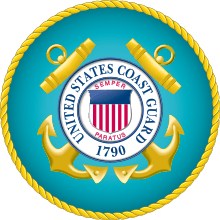
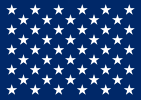

.jpg)

